What Do Illinois Residents Pay at Illinois Public Universities
Relative to Out-of-State Schools?
In consultation with the Illinois public universities, IBHE developed estimates of what undergraduate Illinois residents pay for tuition and fees after factoring in all tuition discounting (MAP, Pell, institutional need- and merit-based aid, tuition waivers, and private scholarships) at Illinois public universities. Student loans and work study were not included in the discounting. For comparison purposes, estimates of what a typical Illinois resident would pay for undergraduate tuition and fees after factoring in all tuition discounting at select out-of-state institutions were also calculated. This was an expansion of previous IBHE DataPoint 2017-7, to include more of the Illinois public universities, and additional out-of-state public universities1.
The analysis focuses on three different comparisons: 1) full weighted tuition and fees for the Illinois institutions relative to advertised tuition and fees for the out-of-state institutions in AY 2016-17; 2) the estimated average amount paid for tuition and fees after all discounting by all in-state students at the Illinois public universities compared to the estimated average paid by all domestic non-resident students at the out-of-state schools; and 3) the estimated average amount paid for tuition and fees among those receiving any sort of discount.
Two sets of comparisons were made: 1) the first set compares the four largest Illinois public universities (UIUC, UIC, ISU, and NIU) to select out-of-state competitors that one would generally consider to be some of the peer institutions of the University of Illinois at Urbana- Champaign. These out-of-state public universities are typically larger (based on enrollment) and have more of a national profile (See Figure 1); and 2) the second set compares seven of the moderately and smaller sized Illinois public universities (based on enrollment) to select moderately and smaller sized out-of-state competitors that are more regionally focused (See Figure 4).
The analysis that follows finds that the estimated averages for undergraduate tuition and fees after discounting compared across Illinois public universities and 15 out-of-state public universities does not support the notion that it is less expensive to attend college out-of-state. On average, nearly all of the comparisons derived from the analysis indicate that it is more cost effective for an Illinois resident to enroll at an Illinois public university.
1Governors State University was not included because the required information was not available.
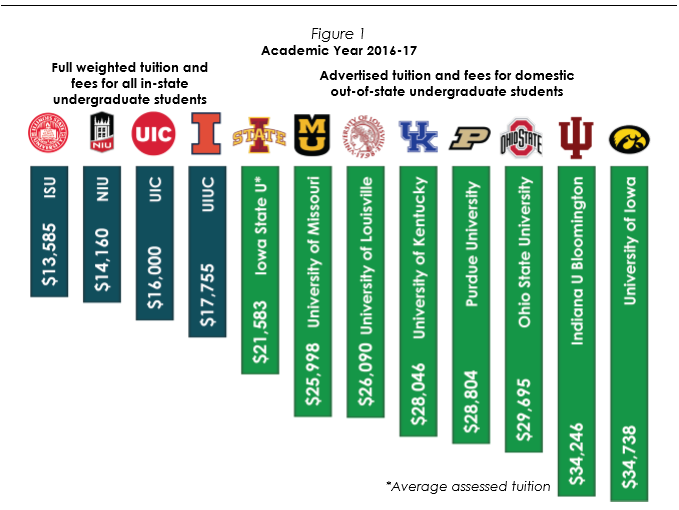
As shown in Figure1, when comparing full weighted tuition and fees at ISU, NIU, UIC, and UIUC to the advertised non-resident tuition and fees at select out-of-state schools, it is significantly less expensive for an Illinois resident to enroll in-state. This holds true for the proportion of Illinois residents paying the full amount for tuition and fees (39% in-state and 27% out-of-state). However, the majority of Illinois residents receive some form of tuition discounting whether they enrolled in-state or out-of-state (assuming the Illinois residents enrolled at out-of-state institutions follow the pattern of all out-of-state students enrolled at those institutions). It should be noted that a higher percentage of the students enrolled out-of-state received some form of tuition discounting when compared to Illinois residents at the Illinois public universities (73% to 61%), but as previously mentioned the sticker price for out-of-state tuition and fees is comparatively higher. For context, student health insurance fees are included in the Illinois totals but not in the out-of-state totals; although the mandatory fee is waivable if the student has health insurance from another source. This mandatory, but waivable, fee ranges from $498 at ISU, $640 at UIUC, $1,140 at UIC, to $2,068 at NIU and makes the ‘sticker’ price for Illinois public universities seem higher than the out-of-state schools that do not include such fees in their advertised price. For example, removing the mandatory but waivable student health insurance fee from NIU’s weighted tuition and fees would result in a ‘sticker’ price of $12,092.
As illustrated in Figure 2, 61% of in-state undergraduates received some form of tuition discount at ISU, NIU, UIC, and UIUC and the other 39% paid full tuition and fees. However, 17% of the in- state undergraduates paid $0 for tuition and fees in AY 2016-17 after all discounting. Nearly three-quarters of domestic non-resident undergraduates received some form of tuition discount from the comparatively larger out-of-state institutions; therefore, only 27% paid the full advertised amount.
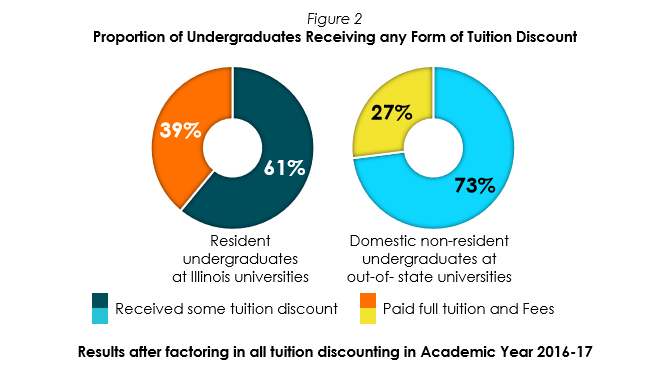
As shown in Figure 3, the estimated average amount paid for tuition and fees across the four largest Illinois public universities (UIUC, UIC, ISU, and NIU) for all in-state undergraduates was $8,046. The estimated average amount paid for tuition and fees for the group receiving the discount was $4,501.
The estimated average amount paid for tuition and fees at the larger out-of-state schools among all non-resident undergraduates was $20,501. The estimated average amount paid for tuition and fees at the larger out-of-state schools among the students receiving any form of tuition discount was $17,491.
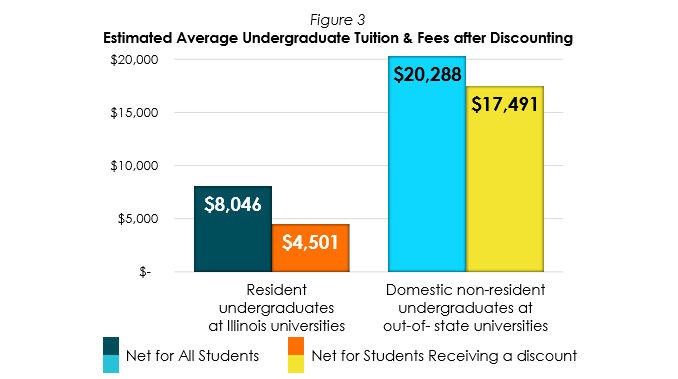
As shown in Figure 4, when comparing full weighted tuition and fees at CSU, EIU, NEIU, SIUC, SIUE, UIS, and WIU to the advertised non-resident tuition and fees at select moderate- to smaller-sized out-of-state public universities, it is significantly less expensive for an Illinois resident to enroll in-state in all cases with the exception of Southeast Missouri State. This sticker price is not the reality for most undergraduate students, as the overwhelming majority of Illinois residents enrolled at moderate- to smaller-sized public institutions received some form of tuition discount whether they enrolled in-state or out-of-state. Less than one-quarter (23%) of Illinois residents enrolled at the comparatively smaller Illinois public universities paid full tuition and fees, relative to 20% of non-residents enrolled at the out-of-state schools. For context, student health insurance fees are included in all of the Illinois totals except SIUE but not in the out-of- state totals; although this mandatory fee is waivable the aforementioned Illinois public universities if the student has health insurance from another source. This mandatory, but waivable, fee ranges from $220 at EIU, $1,196 at UIS, $1,250 at SIUC, $1,334 at CSU, $1,410 at WIU, to $1,863 at NEIU.
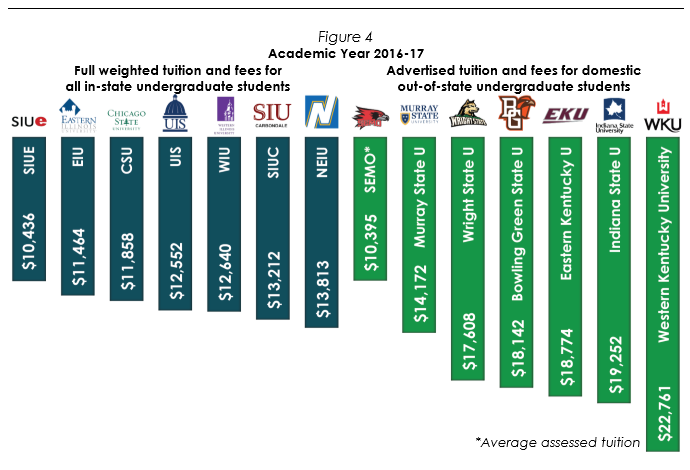
As illustrated in Figure 5, 77% of in-state undergraduates received some form of tuition discounting at SIUC, SIUE, WIU, NEIU, EIU, CSU,
and UIS and the other 23% paid full tuition and fees. However, 22% of the undergraduates across those three Illinois public universities paid $0 for tuition and fees in AY
2016-17. In other words, there were nearly as many Illinois residents who paid $0 for tuition and fees at Illinois public universities as there were Illinois
residents who paid full tuition and fees. Four out of every five (80%) of domestic non-resident undergraduates received some form of tuition discounting from
the seven moderate- to smaller-sized out-of- state institutions; therefore, only 20% paid the full advertised amount.
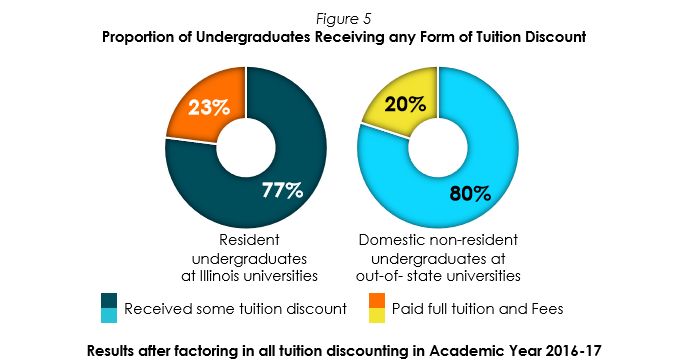
As shown in Figure 6, the estimated average amount paid for tuition and fees across the moderate- to smaller sized Illinois public universities for all in-state undergraduates was $4,539. The estimated average amount paid for tuition and fees among in-state undergraduates receiving any sort of tuition discount was $3,165.
The estimated average amount paid for tuition and fees at the comparatively smaller out-of- state schools among all non-resident undergraduates was $10,055. The estimated average amount paid for tuition and fees at the
out-of-state schools among the students receiving any form of tuition discount was $8,421.
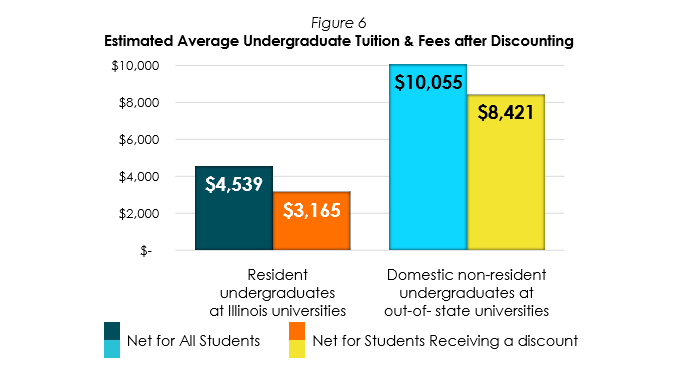
Illinois Board of Higher Education. (May 2018). What do Illinois residents pay… (IBHE DataPoints 2018-7). Springfield, IL.